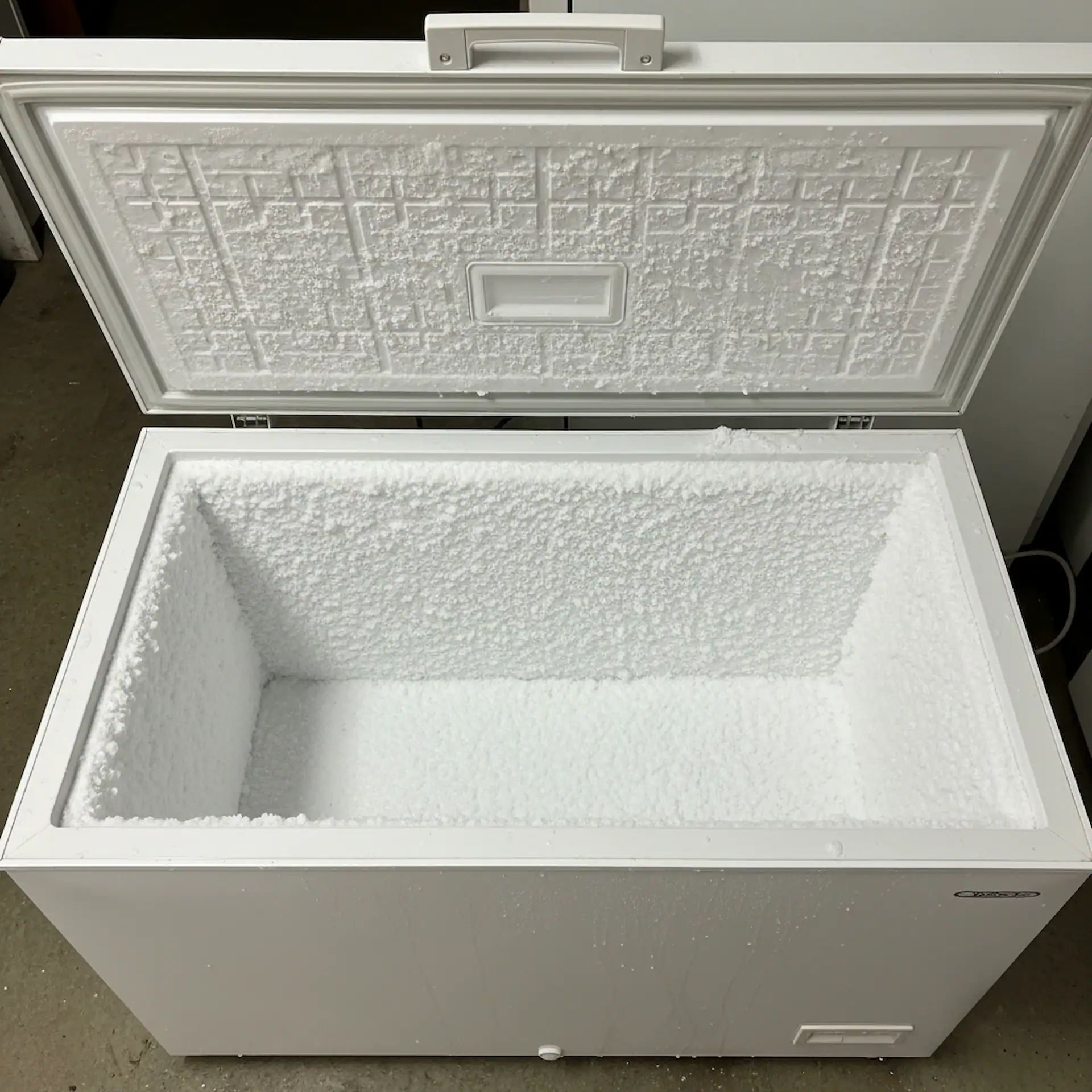
Question: Can Chest Freezers Be Frost-free?
Answer: No, traditional chest freezers are not frost-free and require manual defrosting. The technology uses fans and heating elements, which is inefficient for their design and typically found in upright models. Some may be marketed as “low-frost” but are not truly frost-free.
The Reality of Frost-Free Chest Freezers
Many people wonder if chest freezers can be frost-free. The simple answer is that true frost-free chest freezers are extremely rare in the consumer market. Chest freezers are famous for their large storage capacity and incredible energy efficiency. This efficiency comes from a simple design where cold air, which is dense, stays inside when you open the lid. Most models rely on this design and require manual defrosting to remove ice buildup over time. This manual defrosting process is a significant chore for many owners.
The demand for a convenient, low-maintenance freezer has made frost-free technology very popular in upright models. Consumers want to avoid the hassle of emptying their freezer, chipping away ice, and cleaning up melted water. A frost-free appliance automates this entire process, offering a set-and-forget experience. This convenience is the main reason people search for a frost-free version of the spacious chest freezer. While the technology exists, manufacturers have largely avoided putting it into chest freezers for specific design, cost, and efficiency reasons.
This article explores why frost-free chest freezers are so uncommon. We will explain how frost-free systems work and why they conflict with the core benefits of a chest freezer design. We will also compare manual defrost models to their frost-free counterparts and present practical alternatives. This information will help you understand the available options and choose the best freezer for your household’s long-term food storage needs.
How Frost-Free Technology Works
Frost-free technology prevents ice from accumulating inside a freezer. This process relies on a combination of components that work together in a cycle. The main parts are a fan, a heating coil, and a timer. Frost forms when warm, humid air enters the freezer and comes into contact with its cold interior surfaces. The moisture in the air instantly freezes, creating a layer of ice crystals that grows over time.
A frost-free system actively manages this moisture. A fan constantly circulates cold, dry air throughout the freezer compartment. This circulation helps maintain a consistent temperature and prevents ice from settling on your food packages or the freezer walls. The key part of the system is the automatic defrost cycle. A timer typically activates a heating coil wrapped around the freezer’s evaporator coils several times a day. This heater warms the coils just enough to melt any frost that has formed on them.
The melted frost turns into water, which drips into a collection pan at the bottom of the freezer. From there, the water drains out to an external pan near the compressor, where the heat from the running motor causes it to evaporate harmlessly into the air. This entire cycle happens automatically without any intervention. You never see the ice, and you never have to defrost the unit manually. This system is very effective but adds mechanical complexity and energy consumption to the appliance.
Click here for more information on Toronto cabinet refacing
Related Article: Does a Chest Freezer Work Better Full or Empty?
Related Article: Can You Plug a Chest Freezer Into Any Outlet?
Manual Defrost and Auto-Defrost Models Compared
Choosing a freezer involves comparing the benefits of manual defrost models with the convenience of auto-defrost, or frost-free, systems. Each type has distinct advantages and disadvantages that cater to different user priorities. Understanding these differences is key to making a confident purchase. A manual defrost chest freezer is often the most economical choice both in upfront cost and long-term energy use.
On the other hand, a frost-free upright freezer offers unmatched convenience, saving you the time and effort of a difficult chore. The best option depends on your budget, how you plan to use the freezer, and how much maintenance you are willing to perform. Below is a direct comparison to help you weigh the pros and cons of each freezer style.
-
Manual Defrost Chest Freezers
These models are praised for their efficiency and consistent cold. They are ideal for long-term storage of bulk foods. Their simple design contains fewer mechanical parts that could fail over time.
- Pros: Lower purchase price, greater energy efficiency, quieter operation, and a more stable temperature environment which reduces the risk of freezer burn.
- Cons: Requires manual defrosting one to two times per year, and ice buildup can slowly reduce usable storage space and efficiency if not managed.
-
Frost-Free (Auto-Defrost) Upright Freezers
These freezers are designed for total convenience. Their upright design with shelves makes organizing and accessing food items much easier than with a deep chest freezer.
- Pros: Eliminates the need for manual defrosting, provides better organization with shelves and door bins, and makes it easy to see and retrieve items.
- Cons: Higher initial cost, uses more electricity due to the fan and defrost cycles, temperature fluctuations can increase the risk of freezer burn, and has less usable storage space for its external size.
Effective Alternatives to a Frost-Free Chest Freezer
Since true frost-free chest freezers are nearly impossible to find, consumers should consider effective alternatives that meet their needs. The most direct alternative is a frost-free upright freezer. These models are widely available from numerous brands and in various sizes. An upright freezer offers the ultimate convenience of never needing to defrost. The internal shelves and door bins also make organizing food simple, so you can find what you need without digging through layers of frozen goods. While they use more energy than a chest freezer, for many households, the convenience and organizational benefits are a worthwhile trade-off.
If you are set on the efficiency and storage capacity of a chest freezer, the best option is to embrace a manual defrost model and adopt strategies to make the process easier. You can minimize frost buildup by limiting the time the lid is open, ensuring the lid gasket creates a tight seal, and avoiding placing hot or uncovered foods inside. When it is time to defrost, plan it for a cooler day. Use fans to speed up the melting process and place towels around the base to catch water. Defrosting once or twice a year is a manageable task that preserves the freezer’s efficiency and longevity.
Some manufacturers also offer “low-frost” or “reduced-frost” chest freezers. These are not fully frost-free but include design elements that slow down ice accumulation. They may have improved seals or internal systems that reduce moisture. These models can extend the time between manual defrosts, offering a good compromise between a standard chest freezer and a fully frost-free system.
How to Choose the Best Freezer for Your Needs
Selecting the right freezer requires you to evaluate your priorities regarding cost, convenience, and storage habits. Answering a few key questions can quickly guide you to the best choice for your home. First, consider your budget. Manual defrost chest freezers almost always have a lower initial purchase price than frost-free upright models of a similar capacity. They also cost less to operate over the long term, which can lead to significant energy savings over the appliance’s lifespan.
Next, think about convenience and maintenance. How much do you value your time? If the idea of spending a few hours once or twice a year emptying and defrosting a freezer sounds unbearable, then a frost-free upright freezer is the clear winner. Its automated system handles all the ice management for you. However, if you do not mind a bit of periodic maintenance in exchange for greater efficiency and lower running costs, a manual defrost chest freezer remains an excellent option.
Finally, assess your food storage needs. Do you buy food in bulk or store large items like whole turkeys or big cuts of meat? A chest freezer offers a wide, open space perfect for irregularly shaped items. Do you prefer to have your food neatly organized and easily accessible? An upright freezer with its shelves and bins allows you to see everything at a glance. Your answer will point you toward the freezer style that best fits your lifestyle.
Conclusion
The question “Can chest freezers be frost-free?” has a clear answer: while technically possible, they are not a common product for very practical reasons. The core appeal of a chest freezer lies in its simple, highly efficient design that provides maximum storage for the lowest energy cost. Integrating frost-free technology, with its fans, heaters, and vents, fundamentally undermines these advantages. It increases the purchase price, raises energy consumption, and reduces the available storage space. As a result, manufacturers focus this convenient technology on upright freezers, where the trade-offs are more acceptable to consumers who prioritize organization and zero maintenance.
Your final decision depends entirely on what you value most in an appliance. If your primary goals are maximizing long-term food storage, achieving the lowest possible energy bill, and securing a consistent, stable freezing environment to prevent freezer burn, the manual defrost chest freezer remains the undisputed champion. The minor inconvenience of annual defrosting is a small price for its superior performance and economy. If, however, your lifestyle demands absolute convenience, easy organization, and freedom from maintenance chores, the frost-free upright freezer is the ideal solution. By understanding the distinct benefits of each type, you can now confidently select the freezer that perfectly aligns with your budget, space, and food storage habits.

Blue Malue Get in touch with Blue here.
